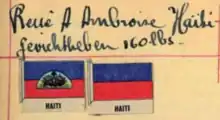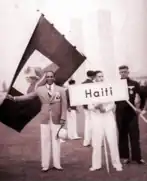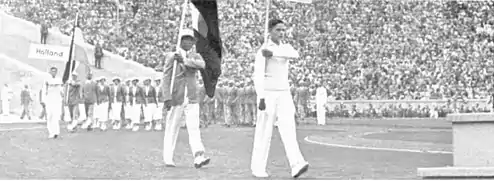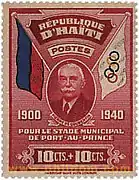| Haiti at the 1936 Summer Olympics | |
|---|---|
.svg.png.webp) | |
| IOC code | HAI |
| NOC | Comité Olympique Haïtien |
| in Berlin | |
| Competitors | 1 in 1 sport |
| Flag bearer | René A. Ambroise |
| Medals |
|
| Summer Olympics appearances (overview) | |
Haiti was set to participate at the 1936 Summer Olympics in Berlin, Germany, but its only athlete, weightlifter René Ambroise, pulled out due to injury. In the days before the Games began, the Liechtenstein delegation noticed that its national flag was identical to that of Haiti, however, resulting in both altering the flags for the opening ceremony and, in 1937, Liechtenstein changing its flag.
Organisation
André Chevallier was the president of Haiti's National Olympic Committee in 1936 and lead the nation through the organisation process.[1] The nation had been invited to participate on 20 December 1933,[1] and were sent ten Olympic programmes in March 1935, though in Spanish rather than national language French.[2] Their small delegation (twenty Olympic identity cards and one press ticket were issued) arrived in Germany on 24 July 1936 before departing on 4 August. Their attaché in Berlin was Edouard Voigt, and the military officer assigned to serve them was Captain v. Hülsen.[1]
In order to travel to Germany, the Haitian delegation first had to go to New York to catch an Atlantic crossing with the US Armed Forces on the SS Manhattan, barely arriving in New York in time.[3]
Flag incident
Haiti's only athlete in 1936 was weightlifter René A. Ambroise (from Jacmel),[4] a student based in Paris, where he had taken up the sport. He carried the Haitian flag at the opening ceremony;[4] having discovered that the civil flag of Haiti was identical to that of Liechtenstein when the latter delegation arrived at the Games, both nations decided to carry different flags in the opening ceremony. Liechtenstein received approval from their government to carry their flag upside-down and add a "Prince's Hat" crown in the corner, while Ambroise added the national crest to his flag (to make it the state flag).[5] As a nation, Liechtenstein then changed its flag in 1937.[6][7]
On the day of the opening ceremony, The New Yorker ran an Olympic cover which featured the Haitian state flag, including the crest.[8] Stamps issued in Haiti in 1939 which represented the Olympics used the civil flag, without a crest.[9]
Weightlifting

Ambroise was set to compete in the middleweight weightlifting event,[1][2] but he injured himself in training the day after the opening ceremony and had to pull out.[5] The injury was a severe muscle tear in his right leg, bad enough to require hospitalisation and prevent Ambroise from even watching the Games. When he was interviewed while injured, he said that he believed he was given the pain for unwittingly being a disappointment to his country.[10]
Ambroise had not been hopeful of his chances; speaking to The New Yorker in July 1936, he said that he struggled to lift as much as men lighter than himself and had the bad habit of using his elbows, reflecting that he did not have the time to improve his form to an Olympic level.[11]
References
- 1 2 3 4 "Official Report 1936 v.1". LA84 Foundation. pp. 16, 25, 98, 186, 214, 216, 257, 311, 546, 552, 596, 597 and 598. Retrieved 4 September 2022.
- 1 2 "Official Report 1936 v.2". LA84 Foundation. p. 707, 1110. Retrieved 4 September 2022.
- ↑ "Gewichtheben". Bilder Deutscher Geschichte Cigaretten Bilderdienst Olympia 1936 Band 2. 1936. p. 114.
- 1 2 "René Ambroise". Olympedia. Retrieved 4 September 2022.
- 1 2 "Liechtenstein change of flag" (PDF). International Society of Olympic Historians: 28. 2019.
- ↑ Rainey, Venetia (24 July 2012). "Flag bearing: a potted history". Reuters. Retrieved 26 June 2014.
- ↑ "Liechtenstein". The World Factbook. CIA. Retrieved 26 June 2014.
- ↑ "The New Yorker August 1, 1936 Issue". The New Yorker. Retrieved 4 September 2022.
- ↑ "Haiti - Postage stamps - 1939 - Port-au-Prince Athletic Stadium Fund". Stamp World. Retrieved 4 September 2022.
- ↑ "René Ambroise, unico representante de Haiti, esta doente". Diario Carioca (in Brazilian Portuguese). 7 August 1936. p. 7, column 3.
- ↑ "Standing Choke". The New Yorker. 18 July 1936. Retrieved 4 September 2022.


